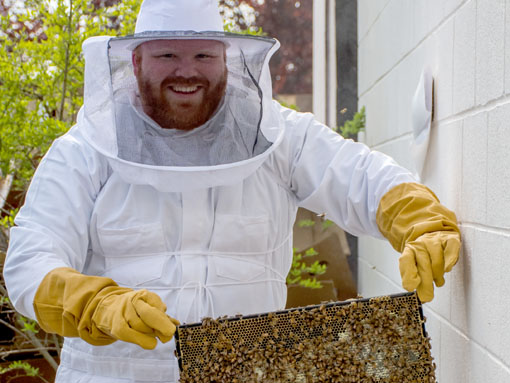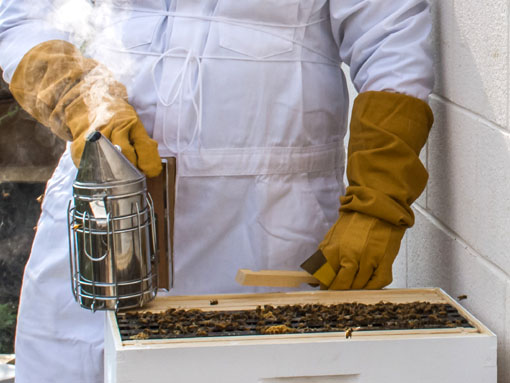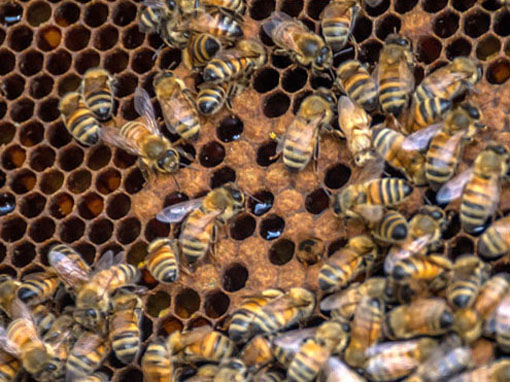
Beekeeping attire is not only fashionable, but also functional, as Nick can attest. Photo credit: Ian Shepstone.
Spring is definitely here at our nursery, and things are buzzing with excitement…literally!
This spring, Nature’s Perspective Landscaping is proud to welcome 10,000 new friends to our company. This past Saturday, we established our first-ever beehive in our nursery and we are buzz-side ourselves.
The population of honey bees has drastically declined in recent years due to several different factors including, but not limited to, Colony Collapse Disorder or CCD, new parasites such as the Varroa Mite, and the use of different pesticides and herbicides that cover the plants that bees visit to gather pollen. We established our hive to raise awareness of the decline, support these precious pollinators and show friends and neighbors just how easy it is to become a hobby beekeeper.
Here are some beekeeping basics if you are considering starting a hive of your own.
Step 1: Confirm that a beehive is allowed where you live.
This is the first question a new beekeeper should ask before they start planning their hive. In Illinois, every apiary (or beehive) must be registered with the State of Illinois. (https://www.agr.state.il.us/bees-apiaries/) The process is extremely easy and costs nothing. In Evanston, a beekeeping license is required and must be renewed each year. The cost is $25 and the city will conduct an inspection of your hive site before issuing a license. During an inspection, the health inspector will look for:
A fence with a locked gate
A sign saying “beware of bees” or similar
A convenient source of water, maintained, not stagnant
Signs that the premises and hive structure have been properly maintained
Proof of the registration of the colony (or colonies) with the IL Dept. of Agriculture, specifically a registration number and documentation
Source: http://www.cityofevanston.org/business/permits-licenses/beekeeping/
Step 2: Educate yourself.
Learning about bees and the beekeeping process is extremely important. There are thousands of books on beekeeping and this is the best place to start your education. After this, taking a class is extremely beneficial. The Chicago Honey Co-op (http://www.chicagohoneycoop.com/) offers one day classes on Saturdays in January and February. These classes are extremely helpful and are highly recommended.

Beehive essentials include a smoker to calm bees, a reducer to protect the hive and a hive tool for handling nuc frames.
Step 3: Purchase your equipment and bees.
Bee orders should be placed in the late winter in order to ensure you get your bees, as a lot of supply is subject to availability. We bought our bees from Dadant and Sons. (www.dadant.com) Dadant has a wealth of knowledge and a great supply of beekeeping supplies, including hives and protective clothing.
Step 4: Choose a site.
Choosing a site is very important to the success of the hive. Classes and books will help determine the best site for you, but a location away from children and disturbance is a good place to start. Notifying neighbors of your new hive isn’t required, but is usually appreciated. Once a site is chosen, set up the hive in anticipation for delivery.
Step 5: Install the bees.
Following the directions of your books and class, install the package and let the bees get to work. Checking the hive once every ten days is beneficial to the hive’s success as signs of parasites or an unhealthy queen can be remedied if caught right away.
Step 6: Collect the honey.
If the colony has enough honey for the winter, the beekeeper can then harvest “liquid gold” to enjoy and share with others.
We look forward to providing updates on our hive’s first year via our Facebook page.

